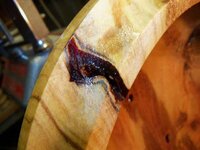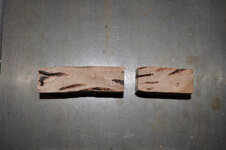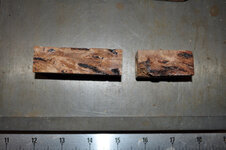I just got an order for a pen using Eucalyptus gum vein burl. I just received the blank today and I'm afraid to turn it. It has major veins in it and I'm afrain it will start ripping apart when I try to turn it.
I do have the woodchuck, but thought I would ask for some advice. Should I do anything before I drill the center out? Should I still turn it on high speed? Should I fill all the vein gaps with CA thin or medium before I start?
Mike
Hi Williams,
I work with a lot of gums/Eucalyptus that are full of resin/gum/pockets, some are liquid (like honey) others are solid/crystallized.
I would expect the blanks you received has solid resin and if so, (a pic would be nice, here...!) its fragility will depend of where and how big those resin vein(s) are...!
Anticipating that they are not totally across the blank, they may require a little soaking with CA at the joint of the wood and the resin, as the adhesion of those crystallized veins are "normally" not to good...!
The first thing I would do is to proceed with the thin CA soaking and then rap the blank tight with some masking tape, even when the glue is still not dry, making sure it has a few layers of tape rapped tight...! This is always the most efficient way to keep fragile blanks together, just in case.
Mark and cut to length, then proceed to see if the faces of your cuts require any CA, if not then, drill the blank(s) to size.
Mounting then in a mandrel on in TBC, wouldn't make much difference for the turning care required. Very sharp tools and light touch are a must, stopping and checking for any areas that become exposed that will require some CA.
This is one of the situations where I would certainly suggest the use of the "Flap" disc system, with 40grit being my preference for the most cutting and shaping, followed by 80 or 100 grits to remove most of the deep scratches/marks.
After that, your normal hand sanding stages would follow, right to the surface coating and polishing...!
I don't know which specie of Gums/Eucalyptus you've got, as there are many types but, there are 2 main types of resin, the one that grows in pockets and normally is very bright red (blood type) and the ones that grown in layers in between the wood grain, this time the colour is dark brown and these are mostly solid...!
Both types make exceptional features within the piece (pen or other) so, I hope that your blank turns out OK (pics would be appreciated...!)
Good luck...!
PS: I'm adding a pic of a recent bowl that I rough turned, where I'm trying to preserve the crystallized resin/gum as a feature. Will see what it happens when the wood is dry enough for me to finish it...!
Cheers
George



